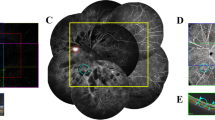Abstract
Purpose
To compare the ability of wide-angle optical coherence tomography angiography (OCTA) with that of ultra-wide field fluorescein angiography (UWFFA) to detect non-perfusion areas (NPAs) or retinal neovascularization (NV) in eyes with diabetic retinopathy (DR).
Methods
Patients with DR underwent UWFFA using the Optos® panoramic 200Tx imaging system and wide-angle OCTA with 12 × 12 mm fields of five visual fixations using the PLEX Elite 9000®. We compared the abilities of UWFFA and OCTA to detect NPAs and NV.
Results
Fifty-eight eyes of 33 patients (mean age, 60.0 years old; female/male, 16/17) with DR were evaluated. NPAs were detected in 47 out of 58 eyes using UWFFA and in 48 eyes using OCTA. NVs were detected in 25 out of the 58 eyes using UWFFA and in 26 eyes using OCTA. The sensitivity for detection of NPA using OCTA was 0.98, and the specificity was 0.82. The sensitivity for detection of NV was 1.0, and the specificity was 0.97.
Conclusion
The wide-angle OCTA seems to be clinically useful for the detection of NPAs or NV.





Similar content being viewed by others
References
Early Treatment Diabetic Retinopathy Study Group (1991) Early treatment diabetic retinopathy study design and baseline patient characteristics. ETDRS report number 7. Ophthalmology 98:741–756
Antonetti DA, Klein R, Gardner TW (2012) Diabetic retinopathy. N Engl J Med 366:1227–1239
LA Y, KT R, LJ T et al (1986) Fluorescein angiography complication survey. Ophthalmology 93:611–617
Hwang TS, Jia Y, Gao SS et al (2015) Optical coherence tomography angiography features of diabetic retinopathy. Retina 35:2371–2376
Salz DA, de Carlo TE, Adhi M et al (2016) Select features of diabetic retinopathy on swept-source optical coherence tomographic angiography compared with fluorescein angiography and normal eyes. JAMA Ophthalmol 134:644–650
Ishibazawa A, Nagaoka T, Takahashi A et al (2015) Optical coherence tomography angiography in diabetic retinopathy: a prospective pilot study. Am J Ophthalmol 160:35–44 e31
Matsunaga DR, Yi JJ, De Koo LO, Ameri H, Puliafito CA, Kashani AH (2015) Optical coherence tomography angiography of diabetic retinopathy in human subjects. Ophthalmic Surg Lasers Imaging 46:796–805
Wessel MM, Aaker GD, Parlitsis G, Cho M, D'Amico DJ, Kiss S (2012) Ultra-wide-field angiography improves the detection and classification of diabetic retinopathy. Retina 32:785–791
Spaide RF (2011) Peripheral areas of nonperfusion in treated central retinal vein occlusion as imaged by wide-field fluorescein angiography. Retina 31:829–837
Ishibazawa A, Nagaoka T, Yokota H et al (2016) Characteristics of retinal neovascularization in proliferative diabetic retinopathy imaged by optical coherence tomography angiography. Invest Ophthalmol Vis Sci 57:6247–6255
Author information
Authors and Affiliations
Corresponding author
Ethics declarations
Conflict of interest
The authors declare that they have no conflict of interest.
Ethical approval
All procedures performed in studies involving human participants were in accordance with the ethical standards of the institutional and/or national research committee and with the 1964 Helsinki declaration and its later amendments or comparable ethical standards.
Informed consent
Informed consent was obtained from all individual participants included in the study.
Additional information
The authors have no proprietary interest in any aspect of this study.
Electronic supplementary material
ESM 1
(ZIP 196962 kb)
Rights and permissions
About this article
Cite this article
Sawada, O., Ichiyama, Y., Obata, S. et al. Comparison between wide-angle OCT angiography and ultra-wide field fluorescein angiography for detecting non-perfusion areas and retinal neovascularization in eyes with diabetic retinopathy. Graefes Arch Clin Exp Ophthalmol 256, 1275–1280 (2018). https://doi.org/10.1007/s00417-018-3992-y
Received:
Revised:
Accepted:
Published:
Issue Date:
DOI: https://doi.org/10.1007/s00417-018-3992-y




